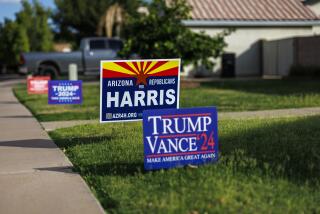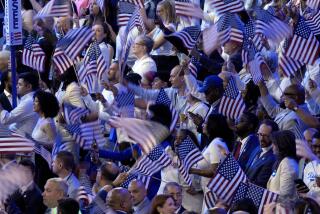Op-Ed: Religious ‘neutrality’ is a myth. Let City Hall light up those Christmas trees, no menorah necessary
In 2003, at age 21, I wrote an op-ed for my hometown paper arguing that the Montpelier, Vt., City Hall should remove its Christmas tree. I argued that Christmas decorations symbolically told Jews like me, and other non-Christians, that city government stood more for the religious majority than for us. Including menorahs and calling the decorations a âholidayâ display didnât help, I argued, since everyone knew what âholidayâ was intended. Furthermore, lumping the two holidays together was demeaning to the dignities of Hanukkah and Christmas alike.
Now, 13 years later, I believe I was mostly wrong. Public Christmas decorations are not just acceptable, but actively good for society.
I have no dramatic epiphany to explain my about-face. And although Iâve aged from 21 to 34 (which is something I canât recommend highly enough), I canât explain my reversal by saying I just mellowed out, because I still donât see this issue as trivial. I believed then, and still believe, that symbolism is important.
Partly, I misunderstood constitutional principles. I thought the 1st Amendment mandated a âwall of separationâ between religion and government. Actually, it protects citizensâ rights to exercise their religions freely, and prevents the government from choosing an official religion. That doesnât mean it canât perform any religious functions. (Thank God for thatâotherwise the government would have to stop paying salaries to military and prison chaplains.)
Too often, religion is pushed out of the public square by misguided devotees of secular âneutralityââpeople like me, 13 years ago.
But the heart of my objection was never about legal doctrine for its own sake. It was emotional; I felt slighted by the municipal Christmas tree, and I assumed that I could only feel equal and welcome in a perfectly neutral society.
Neutrality is OK, except that it isnât possible â not when it comes to religion. Thatâs what Joseph Weiler, a law professor and observant Jew, argued in 2010 before the European Court of Human Rights, as he made the case that Italian public schools should be allowed to display the crucifix. (His side won.)
Weiler told a parable of two Italian children: One has a crucifix hanging on the wall at home, the other does not. If the school displays a crucifix, the first child sees his home practice validated by the school, and vice versa. The answer, Weiler concluded, isnât to chase neutrality, but to âcontextualize [the crucifix] and teach the children in the Italian class tolerance and pluralism.â
In our American public institutions, as in Italian schools, we canât have neutrality â but we can have tolerance and pluralism.
That isnât to say we need menorahs next to the city Christmas tree. On that point I feel much as I did 13 years ago: We should stop lumping Hanukkah and Christmas together. Hanukkah â a holiday celebrating a Jewish rebellion against assimilation into a majority culture â shouldnât have to bear the irony of being assimilated into a majority holiday. And Christmas deserves to keep its particular identity as well.
You donât need to blend holidays to be a good pluralist. In fact, youâre a better pluralist if you donât blend them. Celebrating minority faiths only as part of celebrating the majority faith is just condescending tokenism. Donât throw some kind of Eid ornament onto your âholidayâ tree in December; host a City Hall iftar during Ramadan, whenever it happens to fall. Donât relegate Jewish inclusion to a menorah surrounded by âholidayâ tinsel; build a City Hall sukkah during Sukkot instead. Itâs a more important holiday, and one with much better decorative potential. And, in December, let the Christmas tree be a Christmas tree.
By embracing religious symbolism more openly, without awkwardly failing at neutrality, government will be free to attempt a more meaningful pluralism that engages with the particularity of each group, rather than conflating them all.
In our current political moment, when diversity is under attack, that last point is especially important.
Many in the political and cultural mainstream seem to assume that tribal sub-groups can only undermine national cohesion. But tribal identities can broaden circles of trust. As Edmund Burke put it, âTo be attached to the subdivision, to love the little platoon we belong to in society, is the first principle ... of public affections. It is the first link in the series by which we proceed towards a love to our country, and to mankind.â
You can love your tribe and your country. Youâll probably love your country all the more if you feel it respects your âlittle platoonâ by acknowledging, rather than ignoring it â with a Christmas tree, or a sukkah, or an iftar.
Too often, religion is pushed out of the public square by misguided devotees of secular âneutralityâ â people like me, 13 years ago â to the detriment of true inclusion. Today, I am glad to say to Montpelier, and to all other American cities and towns: Please keep lighting Christmas trees at City Hall. We need to find our way together by kindling the lights of many faiths, not by seeking the perverse â and false â fairness of extinguishing them all.
Seth Chalmer writes about religion and culture.
Follow the Opinion section on Twitter @latimesopinion and Facebook
MORE FROM OPINION
Who was naughty and who was nice in 2016?
Does America have a religion? For the answer, look to Walt Whitman
More to Read
A cure for the common opinion
Get thought-provoking perspectives with our weekly newsletter.
You may occasionally receive promotional content from the Los Angeles Times.










